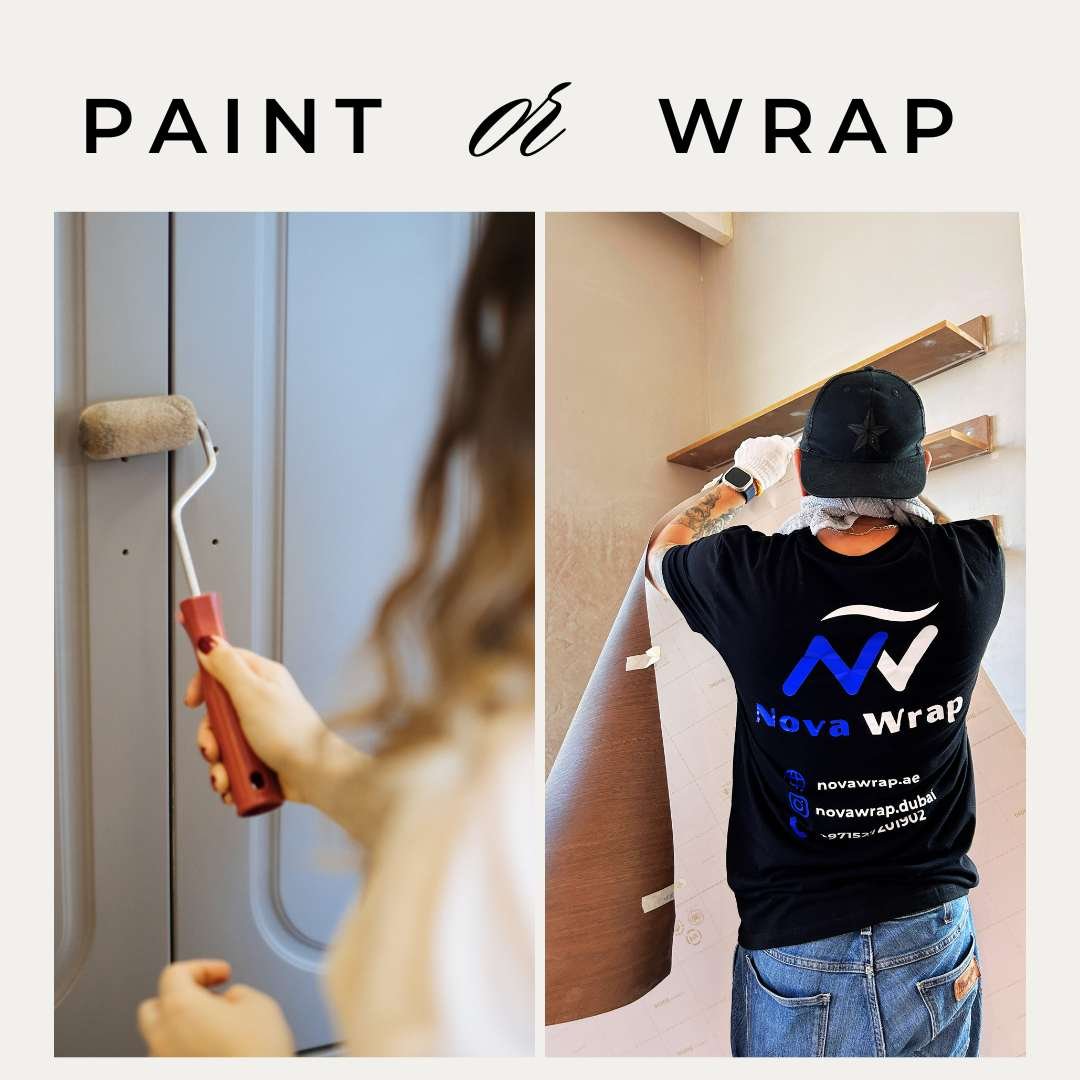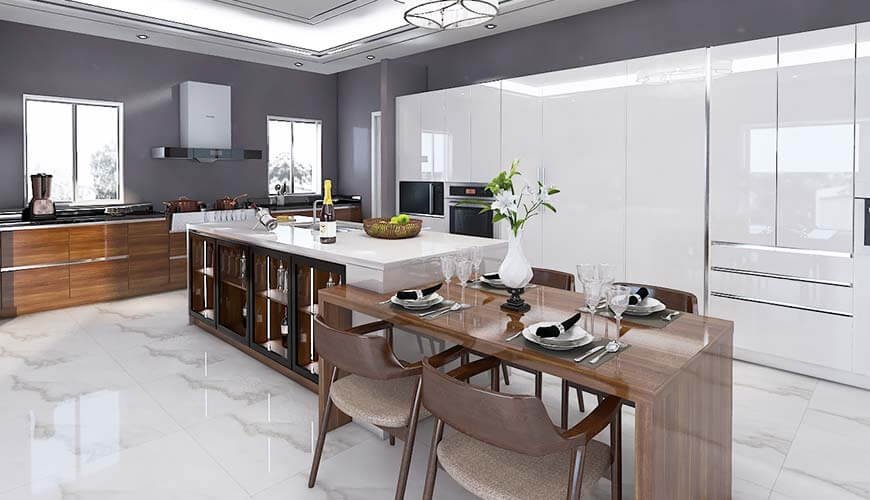Wrapping kitchen cabinets can lead to bubbling and peeling over time. It may also limit design options and customization.
Kitchen cabinet wrapping is a popular method to refresh old cabinets without a full renovation. This technique involves applying a vinyl or laminate film over the existing cabinet surfaces. It is cost-effective and can quickly transform the look of a kitchen.
Despite its benefits, wrapping has certain drawbacks. The film may not adhere well in high-humidity areas, leading to bubbling and peeling. Additionally, the choice of designs and colors might be limited compared to painting or replacing the cabinets. Understanding these disadvantages helps homeowners make informed decisions about their kitchen upgrades.
Table of Contents
ToggleMaterial Quality
Wrapping kitchen cabinets can seem like an easy update. However, the material quality used in wrapping plays a crucial role. Poor materials can lead to several issues over time. Let’s delve into some of the disadvantages related to material quality.
Durability Issues
One key problem with wrapping kitchen cabinets is durability. Some materials used for wrapping are not very strong. They may not last long in a busy kitchen. Low-quality wraps can peel or bubble over time. This reduces the overall look of your kitchen.
Another aspect of durability is resistance to heat and moisture. Kitchens are hot and humid places. Low-quality wraps may not withstand these conditions. They can start to warp or melt, which is not ideal for a kitchen environment.
Wear And Tear
Kitchen cabinets face a lot of wear and tear. You open and close them many times a day. If the wrapping material is weak, it will show signs of wear quickly. Scratches and dents can become visible.
Cleaning can also be an issue. Some wraps are not resistant to cleaning agents. Using strong cleaners can damage the wrap. This makes the cabinets look old and worn out sooner than you expect.

Cost Implications
Wrapping kitchen cabinets might seem like an easy update. But, the cost implications can be significant. It’s essential to consider both initial expenses and long-term investments.
Initial Expenses
The initial cost of wrapping kitchen cabinets can be high. You need to pay for materials and professional installation. Here’s a quick overview:
| Item | Estimated Cost |
|---|---|
| Vinyl Wrap Material | $200 – $500 |
| Professional Installation | $300 – $700 |
| Additional Supplies | $50 – $100 |
This makes the total cost range from $550 to $1,300. This can be more expensive than painting or DIY options.
Long-term Investment
Long-term costs can also add up. Vinyl wraps can peel or fade over time. This means you might need to rewrap the cabinets sooner than expected. Here are some potential long-term expenses:
- Rewrapping every 3-5 years: $500 – $1,000
- Repairing damaged wraps: $100 – $300
- Possible cabinet replacement: $1,000 – $5,000
These costs can accumulate, making wrapping a less cost-effective choice over time.
Installation Challenges
Wrapping kitchen cabinets can transform their look, but it’s not without its challenges. One of the primary concerns is installation challenges. Whether opting for professional help or tackling it yourself, there are hurdles to consider.
Professional Help
Hiring a professional can be costly. Experts charge a premium for their services. The average cost ranges from $500 to $1,500. This price varies based on the size and complexity of the job. Additionally, finding a reliable professional can be difficult. Not all installers have experience with cabinet wrapping. Mistakes or delays can lead to frustration and added expenses.
Diy Difficulties
Choosing to wrap cabinets yourself may seem cost-effective. Yet, it comes with its set of problems. The process requires precision and skill. Without proper tools, achieving a smooth finish can be challenging. Bubbles and creases are common issues. Moreover, removing old adhesive can be time-consuming and messy.
| Challenges | Details |
|---|---|
| Cost | Professional help is expensive. |
| Expertise | Finding skilled installers is tough. |
| Precision | DIY requires a steady hand. |
| Tools | Proper tools are essential for a smooth finish. |
Whether you hire a pro or go the DIY route, installation challenges are inevitable. Understanding these can help in making an informed decision. Proper planning and preparation are key to a successful cabinet wrapping project.
Aesthetic Limitations
Wrapping kitchen cabinets can offer a quick and cost-effective update. However, it can come with aesthetic limitations that might not meet everyone’s taste. Below, we discuss the design restrictions and color fading issues associated with wrapping kitchen cabinets.
Design Restrictions
Wrapped cabinets often have limited design choices. Many wraps feature simple, solid colors or basic patterns. Custom designs might not be available. This can restrict your ability to achieve a unique look.
Additionally, the texture of wraps can feel different. Some wraps may not mimic natural wood or high-quality finishes. This can affect the overall feel of your kitchen space.
Color Fading
Color fading is another significant issue with wrapped kitchen cabinets. Over time, exposure to sunlight can cause the wrap to fade. This can make your cabinets look old and worn out.
Here is a table that highlights the common causes of color fading:
| Cause | Impact |
|---|---|
| Sunlight | Causes the wrap to lose its color |
| Heat | Can lead to discoloration |
| Cleaning Chemicals | May strip the color away |
Using harsh cleaning chemicals can also cause fading. Always use gentle cleaners to maintain the color. Regular care is essential to preserve the look of wrapped cabinets.
Maintenance Requirements
Wrapping kitchen cabinets can look modern and stylish. But, they also come with certain maintenance requirements. These can be tricky for homeowners to manage. Let’s explore some of these challenges.
Cleaning Difficulties
Wrapped cabinets often have a smooth surface. This surface can show fingerprints and smudges easily. Cleaning these marks can become a daily task. Some wraps are not waterproof. Water can damage the wrap if it seeps through. This makes cleaning spills a careful process. Using harsh chemicals can harm the wrap’s finish. So, you need to use special cleaners. These cleaners can sometimes be more expensive.
Repair Complications
Damage to wrapped cabinets can be hard to fix. Small tears or bubbles can appear over time. Repairing these issues is not always easy. You might need to replace the entire wrap. This can be both time-consuming and costly. If the wrap gets damaged, it can expose the original cabinet. This might not match the rest of your kitchen. Finding the exact color and pattern can be difficult. This could lead to mismatched cabinets.

Environmental Impact
Wrapping kitchen cabinets may seem convenient and stylish. But it has significant environmental drawbacks. Understanding these impacts can help you make more informed decisions for your home and the planet.
Non-recyclable Materials
Many kitchen cabinet wraps use non-recyclable materials. Vinyl wraps are a popular choice. Yet, they are not recyclable. This means they end up in landfills. Over time, these materials accumulate and take up space. Disposal issues arise because vinyl does not decompose easily. This adds to the growing problem of plastic waste.
In a table, let’s see how different materials compare:
| Material | Recyclable? | Decomposition Time |
|---|---|---|
| Vinyl | No | 100+ years |
| Wood | Yes | 5-10 years |
| Metal | Yes | 50+ years |
Chemical Emissions
Chemical emissions from wrapped cabinets pose another concern. Many wraps are made using PVC (polyvinyl chloride). During production and disposal, PVC releases harmful chemicals. These chemicals include dioxins and phthalates. They can harm both human health and the environment.
These emissions contribute to air and water pollution. They affect local wildlife and ecosystems. Indoor air quality also suffers. Wrapped cabinets can release volatile organic compounds (VOCs). VOCs can cause respiratory issues and other health problems.
In summary, wrapping kitchen cabinets has serious environmental impacts. Consider these factors before making a choice.
Resale Value
Wrapping kitchen cabinets is a popular trend. However, it can affect your home’s resale value. This section explores the potential downsides.
Potential Decrease
Wrapped cabinets can lead to a potential decrease in home value. Buyers often prefer original materials. Wrapped cabinets can seem like a shortcut. This could raise questions about the quality of other home features.
Wrapped cabinets might not stand the test of time. They can peel or fade. This can make the kitchen look worn out. A worn-out kitchen can lower the home’s appeal. This, in turn, affects the resale value.
Buyer Preferences
Buyers have different tastes. Some may not like wrapped cabinets. They may prefer natural wood or painted finishes. Wrapped cabinets can limit buyer interest. Limited interest can result in a lower selling price.
Buyers might also question the durability of wrapped cabinets. They may see it as a temporary fix. This could make them hesitant to pay a higher price. They might expect to replace the cabinets soon after purchase.
In summary, wrapping kitchen cabinets can impact the resale value. It can lead to a potential decrease and limit buyer preferences. Consider these factors before deciding on this trend.
Alternatives
Wrapping kitchen cabinets can have some drawbacks, such as durability issues and potential peeling. Fortunately, there are alternative methods to update your kitchen cabinets. These alternatives can offer greater longevity and a fresh look without the pitfalls of cabinet wrapping.
Painting Cabinets
Painting cabinets is a popular option. It can breathe new life into your kitchen. This method allows for a wide range of color choices. Paint also creates a smooth, clean finish. Using high-quality paint can make the cabinets durable and easy to clean.
Here’s a simple process for painting your cabinets:
- Remove the doors and hardware.
- Clean the surfaces to remove grease and grime.
- Sand the surfaces for better paint adhesion.
- Apply a primer to ensure the paint sticks well.
- Paint with a durable, kitchen-friendly paint.
- Reattach the doors and hardware once dry.
Replacing Doors
Replacing cabinet doors can be a great alternative. This method can make your kitchen look new without a full remodel. New doors can come in various materials and styles. You can choose from wood, glass, or even metal finishes.
Benefits of replacing doors include:
| Benefit | Details |
|---|---|
| Customization | Choose doors that match your kitchen’s style. |
| Durability | New doors are often more durable than wrapped ones. |
| Easy Maintenance | New materials can be easier to clean and maintain. |
This option also allows for updating the hardware. You can add new handles or knobs for a complete transformation.

Frequently Asked Questions
Are Wrapped Kitchen Cabinets Durable?
Wrapped kitchen cabinets can be less durable than painted or solid wood cabinets.
Does Wrapping Kitchen Cabinets Cause Peeling?
Yes, wrapping can cause peeling over time, especially with exposure to heat and moisture.
Can Wrapped Cabinets Fade?
Yes, wrapped cabinets can fade, particularly if exposed to direct sunlight.
Is Wrapping Kitchen Cabinets Cost-effective?
Wrapping can be cost-effective initially, but long-term maintenance costs may add up.
Does Wrapping Kitchen Cabinets Trap Moisture?
Yes, wrapping can trap moisture, potentially leading to mold and damage.
Are There Design Limitations With Wrapped Cabinets?
Yes, design options may be limited compared to painted or solid wood cabinets.
Is Maintenance Of Wrapped Cabinets Difficult?
Maintenance can be challenging, especially if the wrap gets damaged or starts peeling.
Do Wrapped Cabinets Scratch Easily?
Yes, wrapped cabinets are prone to scratches and other surface damage.
Can Wrapped Cabinets Emit Odors?
Yes, some wraps can emit odors, especially when new or exposed to heat.
Are Wrapped Cabinets Eco-friendly?
Wrapped cabinets are generally not as eco-friendly as solid wood or painted options.
Conclusion
Wrapping kitchen cabinets can lead to peeling, bubbling, and color fading over time. It might seem cost-effective initially, but potential long-term issues could outweigh the benefits. Consider professional advice and weigh all options before deciding. Your kitchen deserves the best care and maintenance for lasting beauty and functionality.


